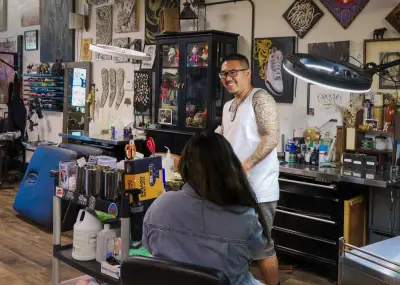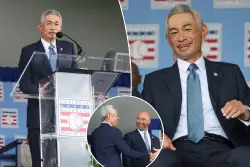The Filipino legacy of Pinoytown in San Jose

Editor s Note This article was written for Mosaic an independent journalism training project for high school students who review and photograph stories under the guidance of professional journalists San Jose s Pinoytown a place where Filipino businesses and families once thrived now shows scarce remnants of its Filipino lifestyle and history Pinoytown took root north of downtown San Jose in a historic Chinatown district originally known as Heinlenville Chinese Japanese and Filipino immigrants settled down there during the s creating a refuge from anti-Asian sentiment The population flourished and Filipinos from the Ilocos region worked and lived in area farms ranches and businesses A mural painted by Jacquelin de Leon includes the sun symbol on the Philippine flag but it s juxtaposed with a graffitied portable bathroom Madeline Aristorenas Mosaic Artists Analyn Bones and Jordan Gabriel led the work on the creation of the Pinoytown mural The work features the Philippines Neighborhood Grocery and the Filipino Area of Santa Clara County staples of the town Madeline Aristorenas Mosaic Artists Analyn Bones and Jordan Gabriel led the work on the creation of the Pinoytown mural The work features the Philippines Neighborhood Grocery and the Filipino District of Santa Clara County staples of the town Madeline Aristorenas Mosaic Benches on the sidewalks of modern-day Japantown give passersby a brief history of the area Madeline Aristorenas Mosaic Art is a way to convey a story and there are artists that are dedicated to that mentioned Robert Ragsac who worked closely with the artists for the Pinoytown mural Madeline Aristorenas Mosaic Robert Ragsac pictured in in Pinoytown the neighborhood where first-wave Filipino enclaves settled Show Caption of A mural painted by Jacquelin de Leon includes the sun symbol on the Philippine flag but it s juxtaposed with a graffitied portable bathroom Madeline Aristorenas Mosaic Expand Pinoy is a term used by Filipinos to refer to people of the Philippines and their heritage as well as those who have relocated abroad The neighborhood changed significantly during World War II when the authorities forcibly removed and imprisoned Japanese Americans allowing Filipinos to take over suddenly vacant buildings Post-war the Filipino population continued to thrive and Pinoytown in the s was home to multiple Filipino businesses This began to change in the s when children of the first-wave Filipinos integrated into wider communities seeking job opportunities and residences outside of Pinoytown In the present day largest part Filipinos have moved on while Japantown remains firmly rooted For a time it seemed the only remnants of Pinoytown were the Filipino Locality Center on North Sixth Street and occasional walking tours around the town Robert Ragsac who was born and raised in the area started the tours They were officially recognized and funded by the Filipino American National Historical Society in The Filipino legacy also has been recognized in art Murals now recall the history and custom of Pinoytown When I walk around downtown and see the murals Ragsac declared it gives me a little pride to live in San Jose Not because of the buildings and history but because of the artwork Madeline Aristorenas is a member of the class of at Silver Creek High School in San Jose


